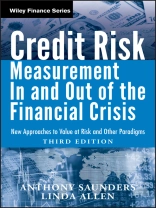A classic book on credit risk management is updated to reflect
the current economic crisis
Credit Risk Management In and Out of the Financial Crisis
dissects the 2007-2008 credit crisis and provides solutions for
professionals looking to better manage risk through modeling and
new technology. This book is a complete update to Credit Risk
Measurement: New Approaches to Value at Risk and Other
Paradigms, reflecting events stemming from the recent credit
crisis.
Authors Anthony Saunders and Linda Allen address everything from
the implications of new regulations to how the new rules will
change everyday activity in the finance industry. They also provide
techniques for modeling-credit scoring, structural, and reduced
form models-while offering sound advice for stress testing credit
risk models and when to accept or reject loans.
* Breaks down the latest credit risk measurement and modeling
techniques and simplifies many of the technical and analytical
details surrounding them
* Concentrates on the underlying economics to objectively
evaluate new models
* Includes new chapters on how to prevent another crisis from
occurring
Understanding credit risk measurement is now more important than
ever. Credit Risk Management In and Out of the Financial
Crisis will solidify your knowledge of this dynamic
discipline.
İçerik tablosu
List of Abbreviations.
Preface.
PART ONE: Bubbles and Crises: The Global Financial Crisis of 2007-2009.
CHAPTER 1: Setting the Stage for Financial Meltdown.
Introduction.
The Changing Nature of Banking.
Reengineering Financial Institutions and Markets.
Summary.
Appendix 1.1: Ratings Comparisons for the Three Major Rating Agencies.
CHAPTER 2: The Three Phases of the Credit Crisis.
Introduction.
Bursting of the Credit Bubble.
Phase 1: Credit Crisis in the Mortgage Market.
Phase 2: The Crisis Spreads–Liquidity Risk.
Phase 3: The Lehman Failure–Underwriting and Political Intervention Risk.
Summary.
CHAPTER 3: The Crisis and Regulatory Failure.
Introduction.
Crisis Intervention.
Looking Forward: Restructuring Plans.
Summary.
PART TWO: Probability of Default Estimation.
CHAPTER 4: Loans as Options: The Moody’s KMV Model.
Introduction.
The Link between Loans and Options.
The Moody’s KMV Model.
Testing the Accuracy of EDFTM Scores.
Critiques of Moody’s KMV EDFTM Scores.
Summary.
Appendix 4.1: Merton’s Valuation Model.
Appendix 4.2: Moody’s KMV Risk Calc.
CHAPTER 5: Reduced Form Models: Kamakura’s Risk Manager.
Introduction.
Deriving Risk-Neutral Probabilities of Default.
Generalizing the Discrete Model of Risky Debt Pricing.
The Loss Intensity Process.
Kamakura’s Risk Information Services (KRIS).
Determinants of Bond Spreads.
Summary.
Appendix 5.1: Understanding a Basic Intensity Process.
CHAPTER 6: Other Credit Risk Models.
Introduction.
Credit Scoring Systems.
Mortality Rate Systems.
Artificial Neural Networks.
Comparison of Default Probability Estimation Models.
Summary.
PART THREE: Estimation of Other Model Parameters.
CHAPTER 7: A Critical Parameter: Loss Given Default.
Introduction.
Academic Models of LGD.
Disentangling LGD and PD.
Moody’s KMV’s Approach to LGD Estimation.
Kamakura’s Approach to LGD Estimation.
Summary.
CHAPTER 8: The Credit Risk of Portfolios and Correlations.
Introduction.
Modern Portfolio Theory (MPT): An Overview.
Applying MPT to Nontraded Bonds and Loans.
Estimating Correlations across Nontraded Assets.
Moody’s KMV’s Portfolio Manager.
Kamakura and Other Reduced Form Models.
Summary.
PART FOUR: Putting the Parameters Together.
CHAPTER 9: The VAR Approach: Credit Metrics and Other Models.
Introduction.
The Concept of Value at Risk.
Capital Requirements.
Technical Issues and Problems.
The Portfolio Approach in Credit Metrics.
Summary.
Appendix 9.1: Calculating the Forward Zero Curve for Loan Valuation.
Appendix 9.2: Estimating Unexpected Losses Using Extreme Value Theory.
Appendix 9.3: The Simplified Two-Asset Subportfolio Solution to the N-Asset Portfolio Case.
Appendix 9.4: Credit Metrics and Swap Credit Risk.
CHAPTER 10: Stress Testing Credit Risk Models: Algorithmics Mark-to-Future.
Introduction.
Back-Testing Credit Risk Models.
Using the Algorithmics Mark-to-Future Model.
Stress Testing U.S. Banks in 2009.
Summary.
CHAPTER 11: RAROC Models.
Introduction.
What Is RAROC?
RAROC, ROA, and RORAC.
Alternative Forms of RAROC.
The RAROC Denominator and Correlations.
RAROC and EVA.
Summary.
PART FIVE: Credit Risk Transfer Mechanisms.
CHAPTER 12: Credit Derivatives.
Introduction.
Credit Default Swaps.
Credit Securitizations.
Financial Firms’ Use of Credit Derivatives.
CDS Spreads and Rating Agency Rating Systems.
Summary.
Appendix 12.1: Pricing the CDS Spread with Counterparty Credit Risk Exposure.
CHAPTER 13: Capital Regulation.
Introduction.
The 2006 Basel II Plan.
Summary.
Appendix 13.1: Loan Rating Systems.
Notes.
Bibliography.
Index.
Yazar hakkında
ANTHONY SAUNDERS is the John M. Schiff Professor of Finance and former chair of the Department of Finance at the Stern School of Business at New York University. He holds positions on the Board of Academic Consultants of the Federal Reserve Board of Governors as well as the Council of Research Advisors for the Federal National Mortgage Association, and has been a visiting scholar at the Comptroller of the Currency and at the International Monetary Fund.
LINDA ALLEN is the Presidential Professor of Finance at the Zicklin School of Business at Baruch College, City University of New York (CUNY), and Adjunct Professor of Finance at the Stern School of Business, New York University. She has been a member of the Standard & Poor’s Academic Council since its formation in 2004. Professor Allen has published extensively in top academic journals in finance and economics.












